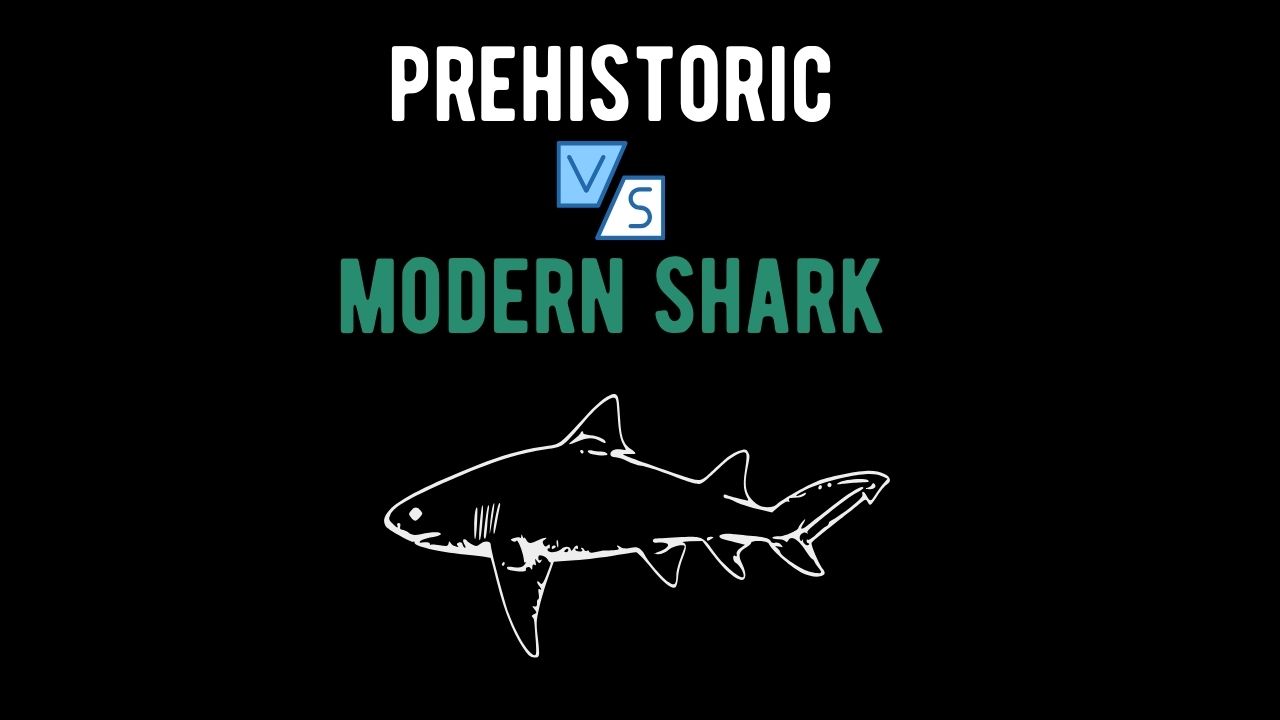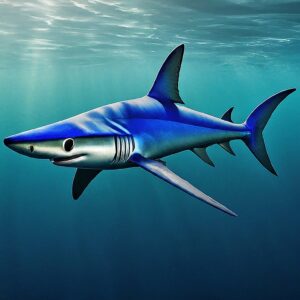
Sharks, as a group of ancient and diverse creatures, have evolved significantly over millions of years. This article delves into the fascinating realm of prehistoric sharks and modern sharks, highlighting their key differences and similarities.
Sharks, with a lineage dating back over 400 million years, have witnessed immense transformations throughout Earth’s history. Comparing prehistoric sharks to their modern counterparts unveils the evolutionary journey that has shaped these formidable predators.
Anatomy and Physical Characteristics
A. Size and Shape
- Prehistoric Sharks:
- Many prehistoric sharks were colossal, with some reaching lengths of up to 80 feet or more.
- Diverse body shapes, including streamlined forms and more angular builds, were common.
- Modern Sharks:
- While modern sharks vary in size, few reach the enormous proportions of their prehistoric relatives.
- Recognizable streamlined shapes dominate the modern shark anatomy.
B. Teeth and Jaw Structure
- Prehistoric Sharks:
- Varied tooth shapes, including serrated edges and specialized adaptations for different diets.
- Some prehistoric sharks had teeth adapted for crushing hard-shelled prey.
- Modern Sharks:
- Diverse tooth shapes but generally more standardized compared to prehistoric sharks.
- Specialized teeth for cutting, slicing, or grasping, reflecting their specific feeding habits.
Evolutionary Adaptations
A. Fins and Tails
- Prehistoric Sharks:
- Diverse fin shapes, including elongated dorsal fins and unique tail configurations.
- Adaptations for various swimming styles and ecological niches.
- Modern Sharks:
- Generally streamlined fins and tails optimized for swift and efficient swimming.
- Tail adaptations for different swimming behaviors, such as the crescent-shaped tail of the great white shark.
B. Senses
- Prehistoric Sharks:
- Evolved sensory organs, including large eyes and specialized electroreceptors.
- Varied adaptations for hunting in different environments, from deep-sea to shallow waters.
- Modern Sharks:
- Enhanced sensory adaptations, with acute senses of smell, vision, and electroreception.
- Adaptations for navigating complex marine environments and locating prey.
Habitats and Environments
A. Ecological Niches
- Prehistoric Sharks:
- Inhabited a range of environments, including ancient oceans and prehistoric seas.
- Adaptations for specific ecological roles, such as apex predators or bottom-dwelling species.
- Modern Sharks:
- Occupy diverse habitats, from coastal waters to open ocean and deep-sea environments.
- Specialized adaptations for specific ecosystems, contributing to their ecological diversity.
Extinction and Survival
A. Extinction Events
- Prehistoric Sharks:
- Experienced multiple extinction events but persisted through various geological eras.
- Adapted to changing environmental conditions and evolving competitors.
- Modern Sharks:
- Face contemporary threats, including overfishing, habitat degradation, and climate change.
- Conservation efforts aim to ensure the survival of various shark species.
Prehistoric Sharks Examples
- Megalodon (Carcharocles megalodon)
- Time Period: Miocene to Pliocene (23 to 3.6 million years ago)
- Size: One of the largest sharks, reaching lengths of up to 82 feet (25 meters)
- Notable Feature: Enormous, serrated teeth adapted for hunting large marine mammals.
- Helicoprion
- Time Period: Permian to Triassic (290 to 250 million years ago)
- Size: Moderate size, around 13 feet (4 meters)
- Notable Feature: Unusual spiral tooth whorl, debated in its placement in the jaw.
- Dunkleosteus
- Time Period: Devonian (360 to 382 million years ago)
- Size: Large, up to 33 feet (10 meters)
- Notable Feature: Armored fish with a bony-plated head, lacking true teeth.
- Xenacanthus
- Time Period: Devonian to Permian (360 to 248 million years ago)
- Size: Typically small to moderate-sized
- Notable Feature: Spine on the back of the head, possibly an adaptation for defense.
- Stethacanthus
- Time Period: Devonian to Carboniferous (358 to 323 million years ago)
- Size: Moderate size, around 3.3 feet (1 meter)
- Notable Feature: Unique dorsal fin with an anvil-shaped extension.
- Orthacanthus
- Time Period: Devonian to Permian (358 to 251 million years ago)
- Size: Ranged from small to large
- Notable Feature: Eel-like body with a distinctive dorsal fin, possibly adapted for freshwater habitats.
- Edestus
- Time Period: Carboniferous to Permian (358 to 272 million years ago)
- Size: Moderate size, around 6.6 feet (2 meters)
- Notable Feature: Saw-like teeth arranged in a blade-like structure.
- Cladoselache
- Time Period: Devonian to Carboniferous (370 to 323 million years ago)
- Size: Small to moderate size
- Notable Feature: Streamlined body, considered an early representative of modern shark characteristics.
- Megalodon (Carcharocles megalodon):
- Time Period: Miocene to Pliocene (23 to 3.6 million years ago)
- Size: One of the largest sharks, up to 82 feet (25 meters)
- Notable Feature: Enormous serrated teeth, apex predator with a global distribution.
- Frilled Shark:
- Time Period: Extant, with ancient relatives dating back to the Late Cretaceous
- Size: Up to 6.6 feet (2 meters)
- Notable Feature: Distinctively fringed gill slits, primitive appearance, deep-sea dweller.
- Bluntnose Sixgill Shark (Hexanchus griseus):
- Time Period: Extant, with ancient relatives dating back to the Jurassic
- Size: Up to 16 feet (4.9 meters)
- Notable Feature: Six gill slits, nocturnal, deep-sea and coastal habitats.
- Orthacanthus:
- Time Period: Devonian to Permian (358 to 251 million years ago)
- Size: Ranged from small to large
- Notable Feature: Eel-like body, distinctive dorsal fin, potentially freshwater habitats.
- Squalicorax:
- Time Period: Cretaceous to Paleogene (145 to 33.9 million years ago)
- Size: Varied sizes
- Notable Feature: Crowded serrated teeth, likely scavengers and opportunistic feeders.
- Scapanorhynchus:
- Time Period: Late Jurassic to Cretaceous (160 to 70 million years ago)
- Size: Moderate size
- Notable Feature: Elongated rostrum, likely a deep-sea predator.
- Carcharocles:
- Time Period: Miocene to Pliocene (23 to 3.6 million years ago)
- Size: Various species, including the Megalodon
- Notable Feature: Includes iconic predatory sharks like Megalodon, apex predators.
- Otodus angustidens/Otodontidae:
- Time Period: Eocene to Miocene (56 to 23 million years ago)
- Size: Large, precursor to Megalodon
- Notable Feature: Well-preserved teeth, considered an intermediate form.
- Cretalamna:
- Time Period: Cretaceous to Paleogene (145 to 33.9 million years ago)
- Size: Varied sizes
- Notable Feature: Diverse genus, included several species, likely had a global distribution.
Conclusion
In the ever-changing tapestry of Earth’s history, both prehistoric and modern sharks have played integral roles. While prehistoric sharks showcase the diversity of ancient marine ecosystems, modern sharks navigate the challenges of a rapidly evolving world. Understanding their shared lineage and distinctive adaptations sheds light on the enduring legacy of these remarkable predators.
FAQs about Prehistoric Sharks vs. Modern Sharks
- Are any prehistoric sharks still alive today?
- No, all known prehistoric shark species are extinct. Modern sharks represent different lineages and species.
- Did prehistoric sharks have larger teeth than modern sharks?
- Some prehistoric sharks had exceptionally large teeth, but tooth size varied among species. Modern sharks also exhibit diverse tooth sizes.
- Were prehistoric sharks more diverse than modern sharks?
- Prehistoric sharks displayed incredible diversity, but modern sharks are also highly diverse, occupying various ecological niches.
- Did prehistoric sharks have different hunting strategies compared to modern sharks?
- Yes, prehistoric sharks had varied hunting strategies based on tooth morphology and ecological roles. Modern sharks employ different strategies based on their adaptations.
- How did the extinction of prehistoric sharks influence modern shark evolution?
- The extinction of certain prehistoric shark species allowed for the evolution of new lineages, contributing to the diversity of modern shark species.
- Are modern sharks more threatened than prehistoric sharks were?
- Modern sharks face numerous threats, including overfishing and habitat loss. While prehistoric sharks experienced extinction events, contemporary threats pose unique challenges.
- Did prehistoric sharks coexist with dinosaurs?
- Yes, some prehistoric sharks coexisted with dinosaurs during various geological periods.
- Do modern sharks share any common ancestors with prehistoric sharks?
- Yes, modern sharks and prehistoric sharks share common ancestors, representing different points along the evolutionary timeline.
- Were prehistoric sharks more resilient to environmental changes than modern sharks?
- Both prehistoric and modern sharks exhibit adaptability to environmental changes, with each facing distinct challenges in their respective eras.
- What role did prehistoric sharks play in ancient marine ecosystems?
- Prehistoric sharks played vital roles as apex predators and contributors to ecosystem balance, similar to the roles of modern sharks in contemporary marine ecosystems.






